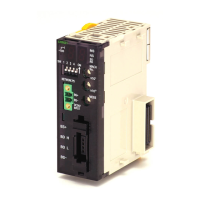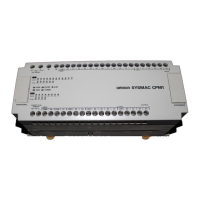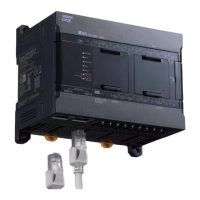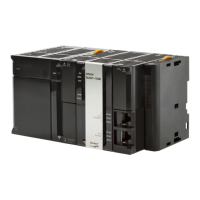3. Instructions
500
CS/CJ/NSJ Series Instructions Reference Manual (W474)
PWR
Applicable Program Areas
Operands
z Operand Specifications
Flags
Instruction Mnemonic Variations
Function
code
Function
EXPONENTIAL POWER PWR @PWR 840
Raises a 32-bit floating-point number to the power
of another 32-bit floating-point number.
Symbol
PWR
Area
Function block
definitions
Block program areas Step program areas Subroutines Interrupt tasks
SFC action or
transition programs
Usage OK OK OK OK OK OK
Operand Description Data type Size
B First base word REAL 2
E First exponent word REAL 2
R First result word REAL 2
Area
Word addresses
Indirect DM/EM
addresses
Con-
stants
Registers Flags
Pulse
bits
TR
bits
CIO WR HR AR T C DM EM
@DM
@EM
*DM
*EM
DR IR
Indirect
using IR
TK CF
B, E
OK OK OK OK OK OK OK OK OK OK
OK
--- --- OK --- --- --- ---
R ---
Name Label Operation
Error Flag ER • ON if the base (B+1 and B) or exponent (E+1 and E) is not recognized as floating-point data.
• ON if the base (B+1 and B) or exponent (E+1 and E) is not a number (NaN).
• ON if the base (B+1 and B) is 0 and the exponent (E+1 and E) is less than 0. (Division by 0)
• ON if the base (B+1 and B) is negative and the exponent (E+1 and E) is non-integer. (Root of a neg-
ative number)
• OFF in all other cases.
Equals Flag
=
• ON if both the exponent and mantissa of the result are 0.
• OFF in all other cases.
Overflow Flag OF • ON if the absolute value of the result is too large to be expressed as a 32-bit floating-point value.
• OFF in all other cases.
Underflow Flag UF • ON if the absolute value of the result is too small to be expressed as a 32-bit floating-point value.
• OFF in all other cases.
Negative Flag N • ON if the result is negative.
• OFF in all other cases.
PWR(840)
B
E
R
B: First base word
E: First exponent word
R: First result word
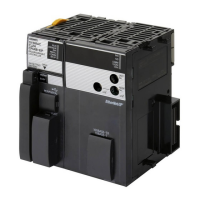
